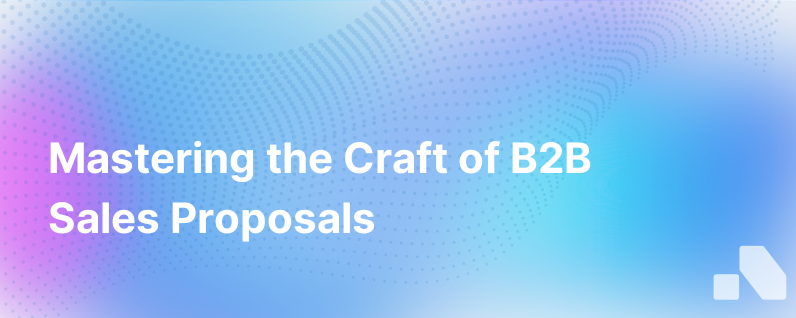
Crafting a compelling sales proposal is an art form—a blend of psychology, marketing savvy, and a deep understanding of your customer’s needs. A well-written B2B sales proposal doesn’t just pitch a product or service, it tells a persuasive story about how a business problem can be solved, the positive change the solution can bring, and why your company is the best choice to enact that change.
In the B2B realm, the stakes are high, and decisions are scrutinized. The proposal phase is critical because it often serves as the cornerstone for your prospective client's purchase decision. Below you will find a structured process that outlines the essential components and strategies of how to construct sales proposals that win business, keep your audience engaged, and demonstrate unmatched value.
Understanding the Customer
The first, and perhaps most essential, step is obtaining a deep understanding of your potential client's business. This includes recognizing their pain points, understanding their industry, acknowledging their competitors, and identifying their corporate ethos and objectives. With this information, you can align your proposal around the client’s strategic goals and demonstrate empathy for their challenges. Being consultative, rather than transactional, encourages a deeper connection with the need for your solutions.
Crafting the Executive Summary
A strong executive summary is crucial. It's often the most-read section of a proposal and sets the tone for everything that follows. Here's a guide to crafting an executive summary that captivates:
-
Begin with the Client's Issues: Clearly articulate the problem or opportunity you've identified. This shows that the focus is on their needs, not your product.
-
Present Your Solution: Describe how your product or service solves their problem or captures their opportunity. Maintain brevity, but be specific enough to intrigue.
-
Highlight Competitive Differentiators: Subtly explain why your solution is better than others in the market.
-
Cover ROI and Value Proposition: Capture how your solution will save time, reduce costs, or increase revenue for the client.
-
End with a Clear Call to Action: Guide them to the next steps with a clear, compelling action.
Detailing the Approach
Your proposal should demonstrate how you will deliver on your promises. This section is where you transition from ‘what’ you are offering to ‘how’ you will accomplish it. Break down the process, from implementation timelines to deliverables, in a manner that is accessible and not overly technical.
Financial Justification
A pricing table is a must-have in any B2B proposal. Here you lay out your costs transparently, outlining what each charge is for and how it connects back to the value you’re providing. Instead of just listing prices, connect each line item to specific results or benefits. If possible, present multiple pricing packages to offer flexibility and control based on the client's budget needs.
Bringing The Proposal To Life With Social Proof
B2B customers want assurances they’re making the right choice, so include testimonials, case studies, and success stories of similar work you’ve done. This part provides the validation for your pitch, showing tangible results and happy customers.
Making It Personal
Customization is the key to a compelling B2B sales proposal. Each proposal should be tailored to the individual client—no cookie-cutter solutions. Personalization involves:
- Understanding and addressing the unique challenges of the prospect
- Aligning the solutions with the goals of the prospect’s organization
- Including industry-specific knowledge to relate to the prospect
Design and Presentation
Don’t let your content down with poor design. The presentation of your proposal is the visual first impression. Ensure it’s professional, clean, and branded throughout. Use visualelements—graphs, charts, infographics—to break up text and represent data in an engaging way.
Avoiding Common Pitfalls
There are several common traps that many fall into when writing proposals:
-
Jargon Overload: Keep the language clear and concise. The goal is to communicate, not to impress with industry buzzwords.
-
Underwhelming Solutions: Ensure that your proposed solution is adequately robust and is presented as transformative rather than just satisfactory.
-
Lack of Follow-up: Follow up is essential. Include next steps, and don’t leave timelines open-ended.
Conclusion—The Subtle Art of Persuasion
In every B2B sales proposal, one is attempting to persuade. This persuasion is not just through words but structure, understanding, customization, and empathy. Above all, a sales proposal communicates how you can solve the client's unique problems effectively and efficiently. It’s about crafting a narrative that speaks directly to them—one that involves the right solution, at the right time, with the right provider. And that provider is your business.
Remember - while what you sell matters, how you sell it can matter even more.
As you continue to develop and refine your proposals, you might find that staying on top of best practices and trends in sales methodologies is a task in itself. Platforms like Aomni can serve as invaluable tools in this process, providing real-time insights, customizable sales content, and competitive intelligence all designed to enhance your sales strategy with practically zero effort.
Sources:
- The Most Important Part Of A Sales Proposal: Executive Summaries That Pop
- Crafting the perfect sales proposal: 10 must-have elements for closing the deal
- 10 Tips for Great B2B Sales Proposals
- 5 Elements Every Sales Proposal Should Include - LivePlan
- Proposal Executive Summary Examples
- 7 Sales Proposal Mistakes and-how to Avoid Them,
- The perfect B2B proposal is 8 steps away
- 5 Essential Elements of a Winning Sales Proposal in B2B Sales